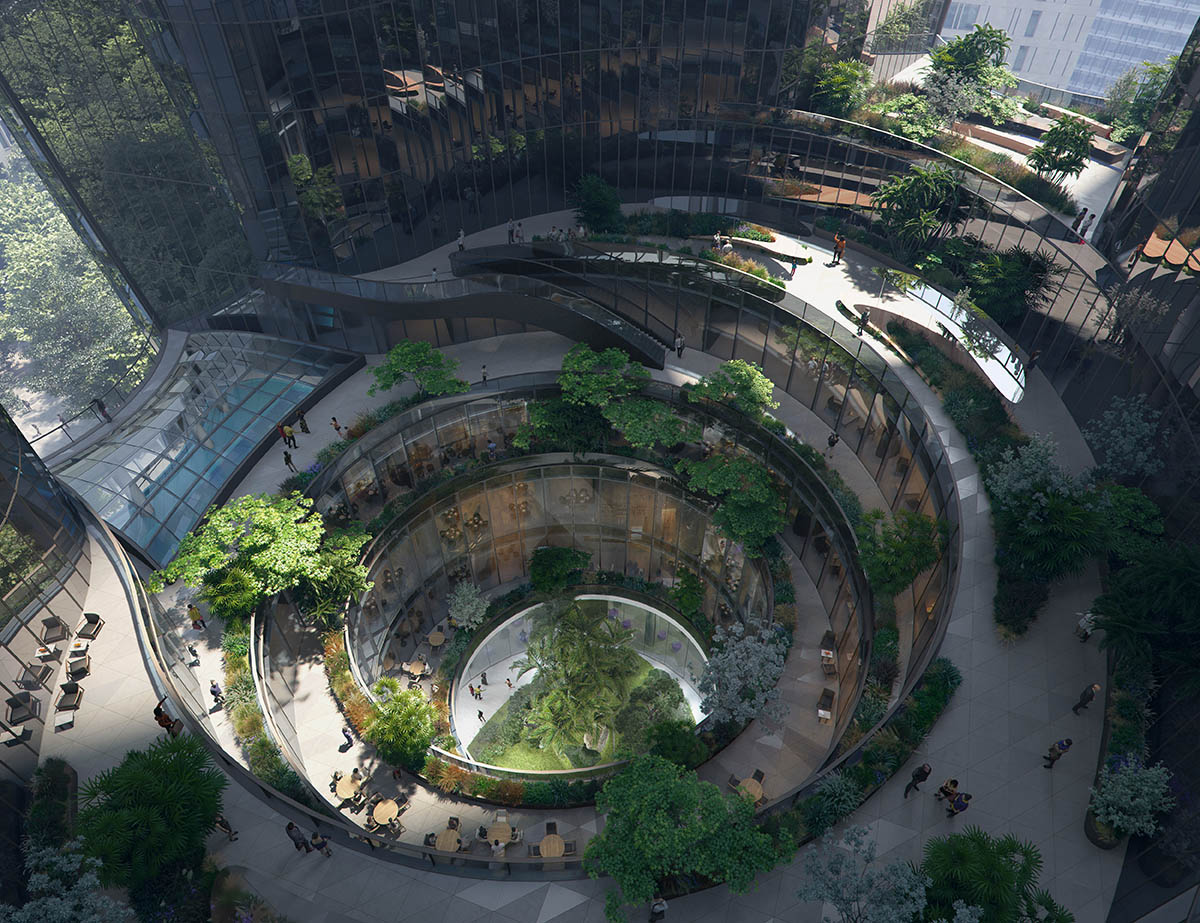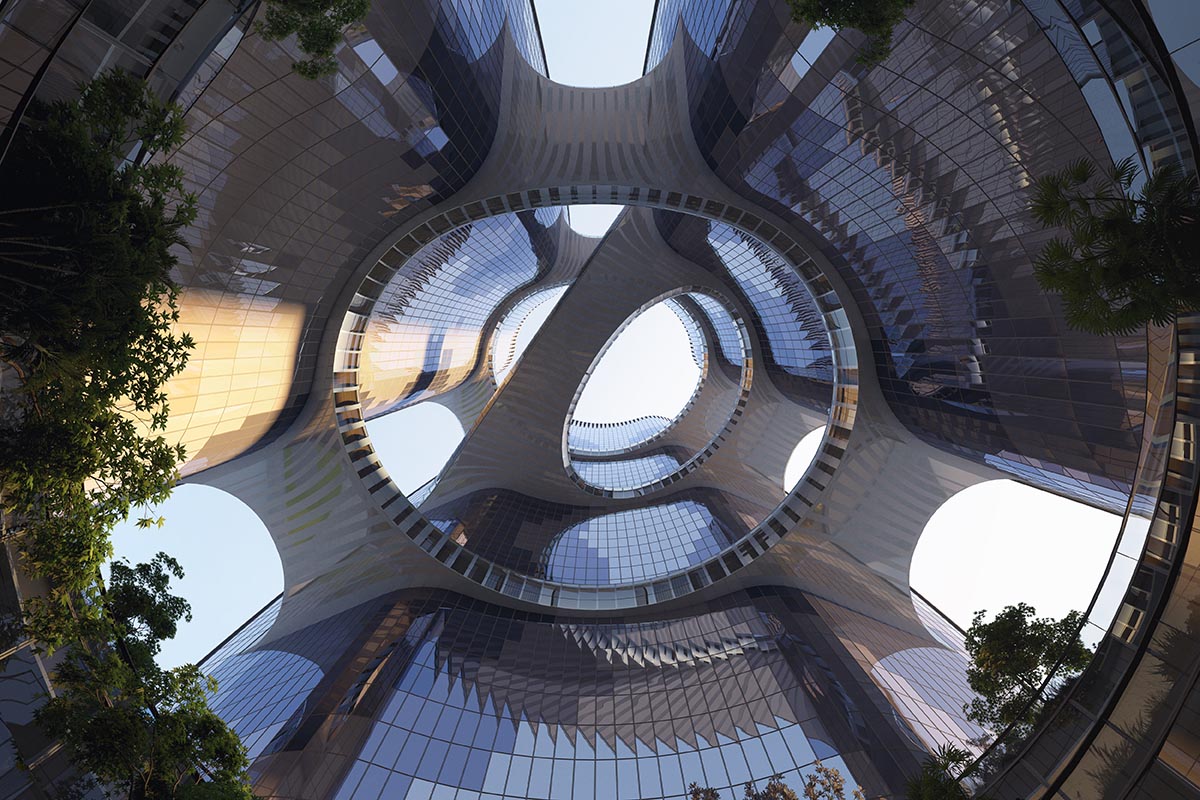Submitted by WA Contents
Zaha Hadid Architects breaks ground on Taikang Financial Centre in Wuhan
China Architecture News - May 04, 2023 - 11:59 3071 views
The foundations and below-ground works have began on Zaha Hadid Architects' Taikang Financial Centre in Wuhan, China.
Called Taikang Financial Centre, the new 266,000-square-metre vertical complex, comprised of three interconnected towers is now set to be completed in 2025.
Developed for Taikang Insurance Group, one of the largest providers of insurance, asset management, health and elderly care in China, the Taikang Financial Centre is set to be built as "a centre of excellence, accomodating teams of leading professionals collaborating with civic, academic and corporate institutions to develop effective systems and networks that will provide a new ecosystem of support for people of all ages across China."
Image © Negativ
Zaha Hadid Architects draws inspiration from Wuhan’s position as a central hub of China’s information and transport networks. The design has a circular composition made of three interconnected towers within the Hankou Riverside Business District's urban masterplan that integrates the Yangtze River park and wetlands to the east as well as the city’s new Central Park to the south.
These new public parks are integral to Wuhan’s sponge city programme that enables the natural storage and infiltration of rainwater to slow its release and aid flood prevention while also facilitating its reuse.
The programme of the towers incorporates offices, apartments, hotel, shopping and dining amenities as well as with cultural and recreational facilities. The new centre, acting as an integrated vertical community, will house over 20,000 people throughout each day, while connecting the city’s new Central Park and riverfront wetlands.
Image © Negativ
Tower One, reaching at 52 floors, sits an adjacent station on Line 1 of the city’s metro network, facing the city.
On the other, Tower Two, reaching at 47 floors, faces the river, and Tower Three, reaching at 50 floors, offers views of the park.
Shops and restaurants are arranged at ground and lobby levels surrounding the garden courtyard that extends vertically as an urban canyon between the three towers.
Other key features of the towers are floating skybridges that consist of public spaces and amenities, while they are also connecting the towers at higher floors. The upper floors feature a rooftop garden terrace in order to provide panoramic views across the city and Yangtze River valley.
"Moving upwards from the shared central courtyards at ground level to the centre’s skybridge terraces and rooftop gardens that surround its central canyon, the design creates a kaleidoscope of the city in a series of interwoven public spaces over many levels," said Zaha Hadid Architects.
"Targeting LEED Gold certification from the US Green Building Council, the circular composition of the Taikang Financial Centre’s three towers provides self-shading throughout the day."

Image © Proloog
The outer skin features external fins with a tapered profiles that extend from each glazing mullion for additional façade shading whilst maintaining unobstructed views of the city.
Thanks to the centre’s envelope, it ensures high-performance in terms of natural daylighting throughout each floor while reducing the centre’s heating and cooling requirements.

Image © Proloog
"MEP systems have also designed to reduce emissions and energy consumption via smart monitoring and control systems using high-efficiency pumps, fans, boilers and chillers as well as waste heat recovery from the exhaust air," the office added.
Water consumption is planned to be reduced with low flow-rate fixtures and the planting of native drought-tolerant vegetation while the development’s rainwater management system is integrated within the district’s sponge city programme.
Recently, Zaha Hadid Architects' Business Stadium Central plans were approved in Vilnius, Lithuania. The firm is also working on the new Chengdu Science Fiction Museum with fluid and radiated-form roof in the city of Chengdu, China.
Project facts
Architect: Zaha Hadid Architects (ZHA)
ZHA Design Principal: Patrik Schumacher
ZHA Project Director: Satoshi Ohashi
ZHA Project Associate Director: Yang Jingwen, Stephane Vallotton
ZHA Project Associates: Martin Pfleger, Di Ding
ZHA Project Architect: Sebastian Andia
ZHA Project Lead: Xiaoyu Zhang
ZHA Project Team: Zheng Xu, Shaofei Zhang, Xuan Zhao, Yuchao Zhang, Pengcheng Gu, Othmane Kandri, Alejandro Garcia Gadea, Armando Solano, Branko Svarcer, Carolina Lopez-Blanco, Catherine McCann, Christian Lindvang Samsoe, Congyue Wang, Dennis Schiaroli, Dimitris K, Erwan Gallou, Frenji Koshy, Houzhe Xu, Jung Yeon Kwak, Lenka Petrakova, Li Jin, Lida Zhang, Meng Zhao, Pelayo Bustillo Macias, Tomasz Starczewski, Xiujing Wang, Yevgeniya Pozigun, Ying Xia, Yuan Feng, Zohra Rougab
ZHA Competition Project Directors: Satoshi Ohashi, Nils Fischer
ZHA Competition Associates: Ed Gaskin, Jingwen Yang
ZHA Competition Team Lead Designer: Sebastian Andia
ZHA Competition Team: Agata Banaszek, Ashwin Shah, Igor Pantic, Jingwen Yang, Juan Liu, Leo Alves, Mei-Ling Lin, Sai Prateik Bhasgi, Sergiu-Radu Pop, Silviya Barzakova
Interiors
Interiors Architect: Zaha Hadid Architects (ZHA)
Design Principal (Interior Architecture): Patrik Schumacher
Project Director (Interior Architecture): Kar-Hwa Ho
Project Associates (Interior Architecture): Bidisha Sinha, Melodie Leung
Project Lead (Interior Architecture): Nailu Chen
Project Team (Interior Architecture): Anna Adebayo, Billy Webb, Boyan Hristov, Enoch Kolo, Haoyang Shi, Jon Krizan, Marco Pavoni, Meysam Ehsanian, Roman Shumsky, Shaofei Zhang, Sonia Renehan
Client: Taikang Wuhan
Architect of record: CABR
Structural engineer: CABR
MEP engineer: Parsons Brinckerhoff
Vertical transportation consultant: Parsons Brinckerhoff
Façade engineer: KT
Environmental consultant: ARUP
Fire consultant: ARUP
Top rendering © Negativ.
> via Zaha Hadi Architects
